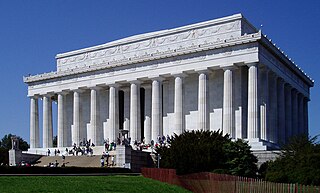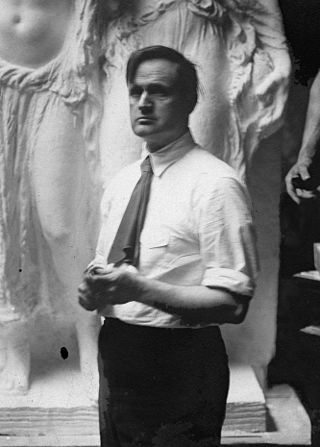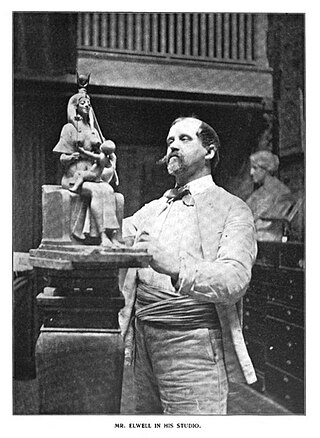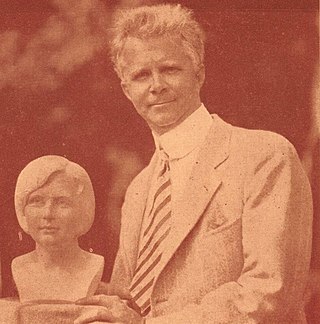
Daniel Chester French was an American sculptor of the late nineteenth and early twentieth centuries. He is best known for his 1874 sculpture The Minute Man in Concord, Massachusetts, and his 1920 monumental statue of Abraham Lincoln in the Lincoln Memorial in Washington, D.C.

William Cullen Bryant was an American romantic poet, journalist, and long-time editor of the New York Evening Post. Born in Massachusetts, he started his career as a lawyer but showed an interest in poetry early in his life. He soon relocated to New York and took up work as an editor at various newspapers. He became one of the most significant poets in early literary America and has been grouped among the fireside poets for his accessible, popular poetry.

Henry Bacon was an American Beaux-Arts architect who oversaw the engineering and design of the Lincoln Memorial in Washington, D.C., built between 1915 and 1922, which was his final project before his 1924 death.

The Panama–Pacific International Exposition was a world's fair held in San Francisco, California, United States, from February 20 to December 4, 1915. Its stated purpose was to celebrate the completion of the Panama Canal, but it was widely seen in the city as an opportunity to showcase its recovery from the 1906 earthquake. The fair was constructed on a 636 acre(1 sq. mi., 2.6 km2) site along the northern shore, between the Presidio and Fort Mason, now known as the Marina District.

Adolph Alexander Weinman was a German-born American sculptor and architectural sculptor.

Karl Theodore Francis Bitter was an Austrian-born American sculptor best known for his architectural sculpture, memorials and residential work.

James Earle Fraser was an American sculptor during the first half of the 20th century. His work is integral to many of Washington, D.C.'s most iconic structures.

Evelyn Beatrice Longman was a sculptor in the U.S. Her allegorical figure works were commissioned as monuments and memorials, adornment for public buildings, and attractions at art expositions in early 20th-century America. She was the first woman sculptor to be elected a full member of the National Academy of Design in 1919.

John Quincy Adams Ward was an American sculptor, whose most familiar work is his larger than life-size standing statue of George Washington on the steps of Federal Hall National Memorial in New York City.

Frederick George Richard Roth often referred to as F.G.R. Roth, was an American sculptor and animalier, well known for portraying living animals. The statue of the sled dog Balto in New York City's Central Park is perhaps his most famous piece.

Isidore Konti was a Vienna-born sculptor. He began formal art studies at the age of 16 when he entered the Imperial Academy in Vienna, where he studied under Edmund von Hellmer. In 1886, he won a scholarship that allowed him to study in Rome for two years. While there he developed a love of Renaissance art that was to affect the nature of his mature sculpture. Upon returning to Austria, Konti worked as an architectural modeler.

Allen George Newman III was an American sculptor, best known for his statue "The Hiker".

Francis Edwin Elwell was an American sculptor, teacher, and author.

Edmond Thomas Quinn was an American sculptor and painter. He is best known for his bronze statue of Edwin Booth as Hamlet, which stands at the center of Gramercy Park in New York City. His larger-than-lifesize bronze bust of Victor Herbert stands near The Pond in Central Park, New York City.

Albert Weinert was a German-American sculptor.
The End of the Trail is a sculpture by James Earle Fraser. Fraser created the original version of the work in 1894, and he subsequently produced numerous replicas in both plaster and bronze. The sculpture depicts a weary Native American man, wearing only the remains of a blanket and carrying a spear. He is hanging limp as his weary horse with swollen eyes comes to the edge of the Pacific Ocean. The wind blowing the horse's tail suggests they have their backs to the wind. The man in the statue is based on Seneca Chief John Big Tree, and the horse was adapted from one in another work, In the Wind. The statue is a commentary on the damage Euro-American settlement inflicted upon Native Americans. The main figure embodies the suffering and exhaustion of people driven from their native lands.

An outdoor bronze sculpture of Fitz-Greene Halleck by James Wilson Alexander MacDonald is installed in Central Park in Manhattan, New York. Commissioned by William Cullen Bryant and James Grant Wilson following Halleck's death in 1867, the statue was cast in 1876 and installed in 1877, becoming the first in Central Park depicting an American. An estimated 10,000 people attended its dedication on May 15, 1877.
Erwin Frey was an American sculptor and educator best remembered for his George Armstrong Custer memorial.

Roger Noble Burnham was an American sculptor and teacher. He is best remembered for creating The Trojan (1930), the unofficial mascot of the University of Southern California.

Bruno Louis Zimm was an American sculptor. He created a variety of works: fountains, memorials, freestanding sculptures, and architectural sculptures.


















